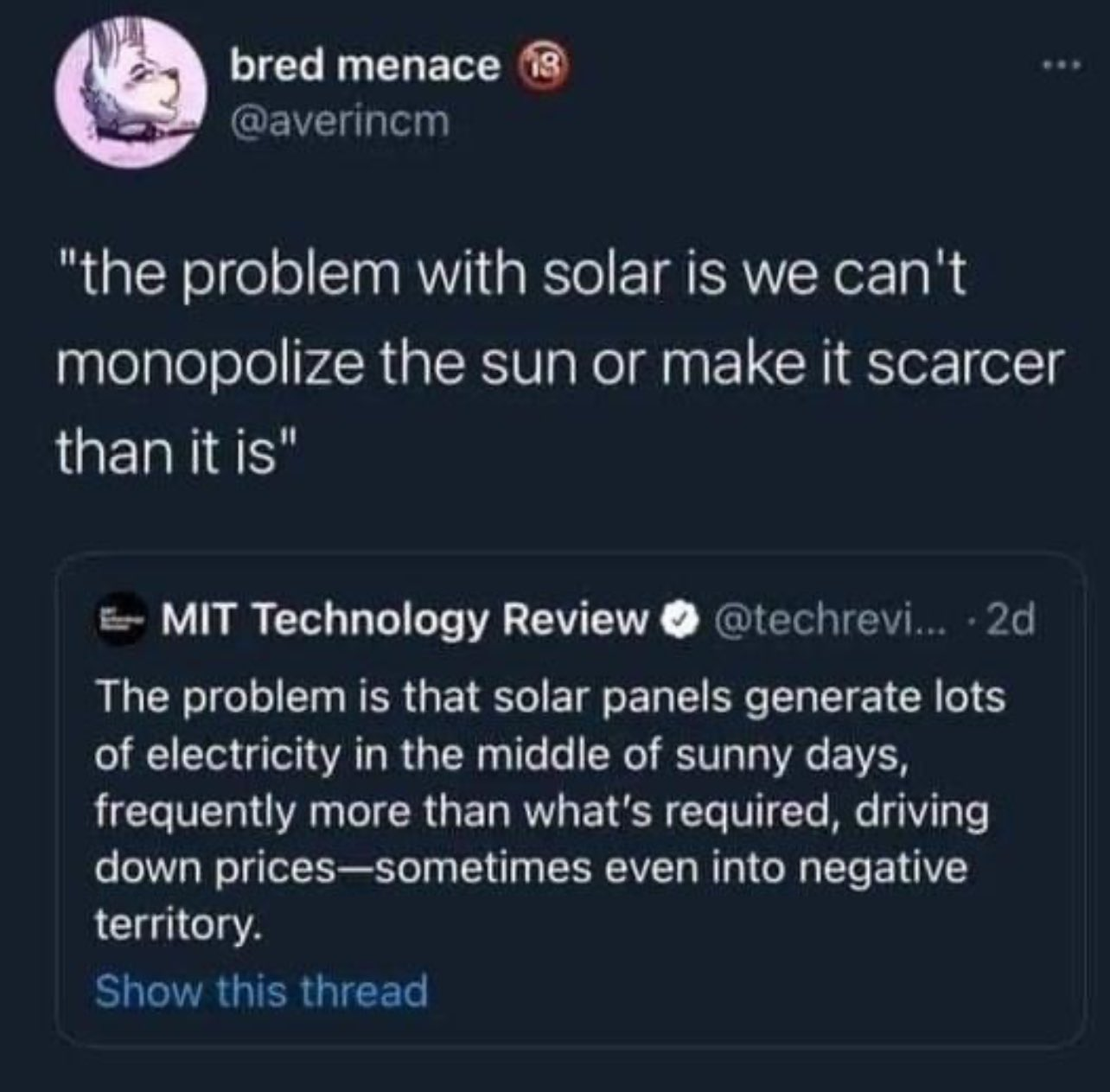this post was submitted on 02 Oct 2024
14 points (100.0% liked)
Microblog Memes
5777 readers
1834 users here now
A place to share screenshots of Microblog posts, whether from Mastodon, tumblr, ~~Twitter~~ X, KBin, Threads or elsewhere.
Created as an evolution of White People Twitter and other tweet-capture subreddits.
Rules:
- Please put at least one word relevant to the post in the post title.
- Be nice.
- No advertising, brand promotion or guerilla marketing.
- Posters are encouraged to link to the toot or tweet etc in the description of posts.
Related communities:
founded 1 year ago
MODERATORS
you are viewing a single comment's thread
view the rest of the comments
view the rest of the comments

From a grid stability point, you can't produce more than is used, else you get higher frequencies and/or voltages until the automatics shut down. It's already a somewhat frequent occurence in germany for the grid operator to shut down big solar plants during peak hours because they produce way more power than they can dump (because of low demand or the infrastructure limiting transfer to somewhere else)
Negative prices are the grid operator encouraging more demand so it can balance out the increased production.
Spot on! I hoped this comment would be higher! The main problem isn't corps not making money, but grid stability due to unreliability of renewables.
To be fair, the original tweet is kinda shit to begin with. They've unnecessarily assigned monetary value to a purely engineering (physics?) problem.
Well I wasn't expecting to find THE right answer in the comments already. Kudos!
And to everyone reading through this post: If you have questions, need more explanations or want to learn more about the options that we have to "stabilize" a renewable energy system and make it long term viable, just ask!
But the thing is, you CAN simply turn them off at the press of a button (or an automated script) so its really a complete non issue. As long as big solar installations control systems are accessible by the grid operators, it should be fine.
If you’re spending billions to build a solar plant that has to turn off all the time during peak hours then you’re wasting your money. That seems like a fundamental issue to me, not a non-issue.
Are there any solar plants that cost a billion dollars each?
Secondly, you want to over build solar, so that you have enough capacity during off peak hours. Grid storage is obviously the better solution, but seems not widely available enough yet.
As someone with a technical background this is the stupidest problem with solar that I don’t get… just turn off the panels in groups until generation is closer to demand… how have engineers not figured that out. And if they have why does this still get written about.
Someone is an idiot. Maybe it’s me?
I’m adjacent to this problem, so I have a little context, but am not an expert at all.
To my knowledge, we don’t have granular control over panels. So we can shut off legs of a plant, but that’s a lot of power to be moving all at once.
Instead, prices are set to encourage commercial customers to intake more power incrementally. This has a smoother result on the grid, less chance of destabilizing.
A customer like a data center could wait to perform defragmentation or a backup or something until the price of power hits a cheap or negative number.
Thanks that’s helpful.
But right…?
Solar plants can be reduced to rationalize supply.
To my understanding. The bigger issue is you can’t as effectively do this with other non-renewables like coal/gas… so this not a solar problem but a problem of legacy power plants.
So stupid. The narrative as well.
Yea, more control over the panels will help with the overgeneration issue.
But there’s other issues like ramping supply to meet peak demand and general generation during non-solar hours that still have to be addressed.
Each have interesting proposals on how to solve them, but they haven’t been developed to the point that they’re ready to be put onto the grid at a large scale.
Piggybacking on your grid stability point, another issue I don’t see getting addressed here is ramp rate.
If we install enough solar where 100% of our daytime load is served by solar, that’s great. But what about when the solar starts to drop off later in the day?
A/Cs are still running while the sun is setting, the outside air is still hot. People are also getting home from work, and turning on their A/Cs to cool off the house, flipping on their lights, turning on the oven, etc.
Most grids have their peak power usage after solar has completely dropped off.
The issue then becomes: how can we serve that load? And you could say “just turn on some gas-fired units, at least most of the day was 100% renewable.”
But some gas units take literal hours to turn on. And if you’re 100% renewable during the day, you can’t have those gas units already online.
Grid operators have to leave their gas units online, running as low as they can, while the sun is out. So that when the peak hits, they can ramp up their grid to peak output, without any help from solar.
There are definitely some interesting solutions to this problem, energy storage, load shifting, and energy efficiency, but these are still in development.
People expect the lights to turn on when they flip the switch, and wouldn’t be very happy if that wasn’t the case. Grid operators are unable to provide that currently without dispatchable units.
Store the surprus of energy from the solar panels and use that as a buffer with batteries or gravity
Why not? Just time it and start it hours before, wind energy could help in that too